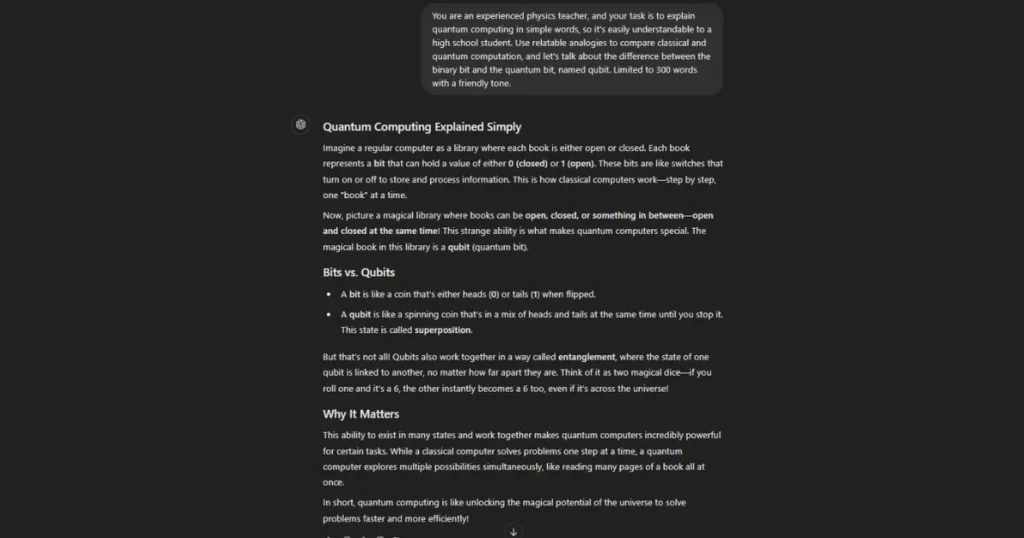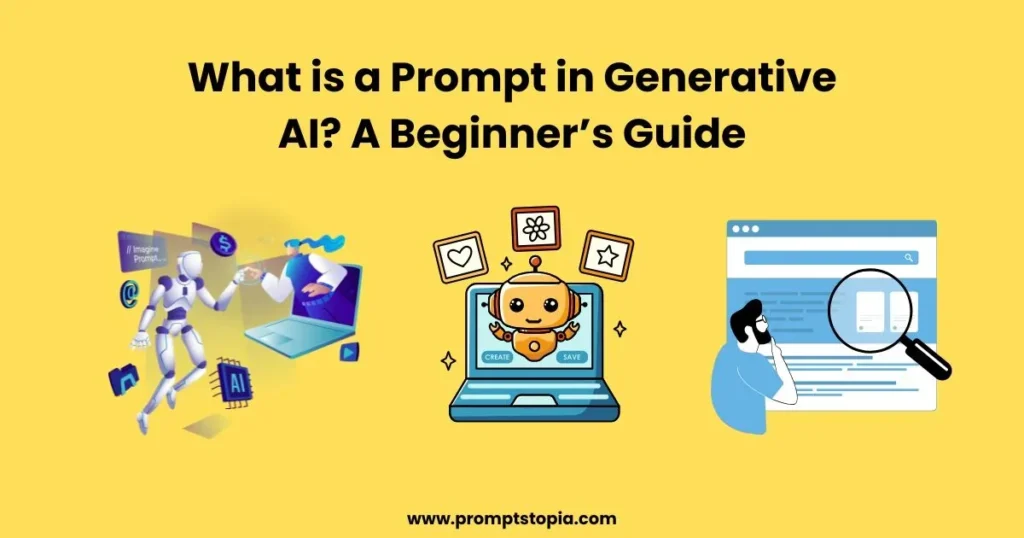Generative AI is one of the most famous and trending types of AI that generates content, like text, images, or music, though only by getting instructions. The main part of the procedure occurs when you instruct the AI by providing it with a “prompt.”
Then what is a prompt in generative AI? It’s just the instruction or question you’re giving to the AI to get the desired response. So, it’s like asking your friend for advice, but you would use different words depending on who you’re speaking to. “What would you wear to a party?” You might ask a friend this question. But if you have something like ChatGPT, you’d say, “Tell me the outfit for a formal evening party in winter.” What does a generative AI prompt mean? An AI model uses this input or instruction to direct its reaction and produce the intended result.
Prompts are important because they affect how the AI gets your request and produces an answer. In other words, a good prompt can make a very big difference in having a correct response versus one that isn’t right.
Table of Contents
Why Prompts Matter
Prompts are the basis of how an AI model understands and responds to your requests. Clear and well-structured input enables accurate and creative output from AI. Off-target is the output in case of vague input. For example, when one just tells the AI to “Write a story,” then the AI may well print something very straightforward. But with a more specific prompt such as “Write a 100-word story about a brave boy who saves his life from snakes around him,” the response develops into something detailed and uniquely suited to your needs.
This specificity plays the most important role in practice-critical applications, such as writing blog posts, coding, or creating AI art. The programming can use detailed prompts to debug errors, while authors can produce content that reflects the correct voice and tone. In image generation, prompts lead the AI to generate pictures based on your imagination.
When crafting prompts, it is essential to ask basic prompt engineering questions such as, “What result am I looking for?” or “What specific details should the AI focus on?” This practice guarantees improved outcomes. When you specifically ask what you want from AI, then AI will give your desired response. The better your prompt, the better your response will be.
How to Craft an Effective Prompt
It is basically like giving a direction; clarity, detail, or specificity are quite essential to your destination. Here it is, in steps:
- Begin with Clarity: State clearly what you want. For example, instead of a prompt like, “Write something,” you would say, “Compose a business email to a customer inquiring about a quote.”
- Add Detail: Mention some information that could be in the tone, format, or key point of the message. Example: “Friendly email to a client named Sarah, explaining our 10% discount on bulk orders.”.
- Provide clear directions at the end: Make sure what you’re asking for is specific. For instance, “Stay within 150 words and include a call to action encouraging Sarah to place an order.”
For example, task-related prompts:
- E-Mail Composition: “Write a formal email to a customer regarding a delayed shipment.”.
- Poetry: Write a 4-line romantic poem about a sunset at the beach.
- Travel Planning: Plan a 3-day family vacation in New York with fun activities for kids as well as budget-friendly dining.
Tone, context, and word choice matter because they help the AI “follow the script.” If you want to become a prompt engineer, then start with experimenting on crafting both simple and complex prompts alongside diverse contexts and see their effects on outputs. Over time, you will master the skill of guiding AI effectively. So, I hope you’ll get the answer to what is a prompt in generative AI. It’s the input or instruction provided to an AI model to guide its response and generate the desired output.
Types of Prompts in Generative AI
Generative AI prompts can be divided into several categories depending on how they steer the AI to its output. Two of the most important categories are open-ended and directive prompts, and they serve completely different purposes.
Open-Ended Prompts
These are very broad, allowing the AI to explore their creativity freely. For example, “Tell me a story” lets the AI determine the theme, tone, and details. Open-ended prompts are useful for brainstorming, storytelling, or idea generation when you want diverse outputs.
Directive Prompts
These are specific and lead the AI to create a kind of response. For instance, “Write a 200-word article about the benefits of morning exercise” narrows down the AI to content, structure, and length. It’s especially good for professional writing, coding, or creating intricate art.
Real-Life Applications
An open-ended prompt like “How was your day?” in a chatbot will generate different responses. With AI-generated art tools like MidJourney, the directive prompt would be something like “Generate a surreal landscape with floating islands and a starry sky—so that the output is creative in specific ways.
Prompts are parallel with the use of tools, excelling in a unique way, like with platforms such as ChatGPT being great at producing texts and others such as MidJourney at visual creativity. Knowing different types of prompts will help you better use AI.
Common Mistakes When Writing Prompts
Sometimes, writing prompts for a generative AI can prove tricky, especially if the output doesn’t match what you had in mind. Here are common pitfalls to avoid:
- Too Vague
A vague prompt like “Tell me something interesting” doesn’t give much direction. You may end up getting responses you didn’t intend to receive. Fix it: Add Clarity.
- Too Complex
The prompt with too many ideas overloads the brain of the AI. For example, “Write a story about a robot that’s sad, loves cooking, travels through space, and meets aliens” may result in an irrelevant answer. To fix it, break down your prompt.
- Lack of Clarity
Unclear instructions lead to misunderstood output. For example, “Write about Paris” may be interpreted as writing about Paris Hilton when in fact one is referring to the city. So, be clear what you want from AI
- Reassurance
Trial and error is part of the process. Don’t hesitate to experiment with different phrasing, levels of detail, and instructions. Over time, you’ll get better at crafting prompts that consistently yield accurate and creative responses.
Example Prompts
- Explaining Quantum Computing to Beginners
“You are an experienced physics teacher, and your task is to explain quantum computing in simple words, so it’s easily understandable to a high school student. Use relatable analogies to compare classical and quantum computation, and let’s talk about the difference between the binary bit and the quantum bit, named qubit. Limited to 300 words with a friendly tone.”

- Writing a Historical Fiction Story
“You are an experienced content writer, and your task is to write a thrilling short story set in 18th-century France during the French Revolution. Hold your attention on a young blacksmith caught between supporting a revolutionary group and keeping his royalist family safe. Include vivid descriptions of the era, 1,000 words or less, and a dramatic tone.”
The Future of Prompts in Generative AI
With advanced models, the prompts are becoming more diversified and efficient. The more sophisticated models currently understand contextual meaning well enough to allow for more natural exchanges. This sets the stage for multimodal prompts; it would enable users to integrate text and images or voice to provide a clue for the AI. For example, a user could upload a photo with a written request to create a detailed caption or even suggest edits.
Learning prompts is essential in tech-driven professions; it’s no longer optional. Be it marketing, education, or design, learning how to create effective prompts transforms the way you interact with AI tools. Platforms such as ChatGPT benefit much more when best practices, such as specifying tone, purpose, and details in requests, are used.
Ultimately, prompts are not about answers alone but also how AI collaborates with us, unlocking creative potential and innovation in various areas.
Conclusion
The prompt is the foundation of generative AI and establishes the output’s precision, originality, and worth. We discussed in this blog what a prompt in generative AI is, its types, and how important it is. Improving your prompts requires practice but can unlock endless possibilities in writing, designing, and beyond.
Remember, ChatGPT best practices include being clear, specific, and intentional in your requests. The answer is closer if the prompt is clearer. The real magic of AI is in how we guide it with our words to bring simple input into wonderful output. Start experimenting and watch your ideas come to life through AI!
FAQ’s
1. Be Specific.
2. Act as if
3. Indicate to it how you would like your output to be displayed.
4. Make use of “do” and “don’t.”
5. Give examples.
6. Think about the audience and the tone.
7. Expand on earlier prompts.
8. Fix errors and provide comments.
If you want your AI software to provide relevant and meaningful insights or content for you, you will need to give clear, rich instructions about what you want. Well-designed prompts can make important tasks easier, streamline workflows, spur collaboration, and simplify decision-making in a group.








